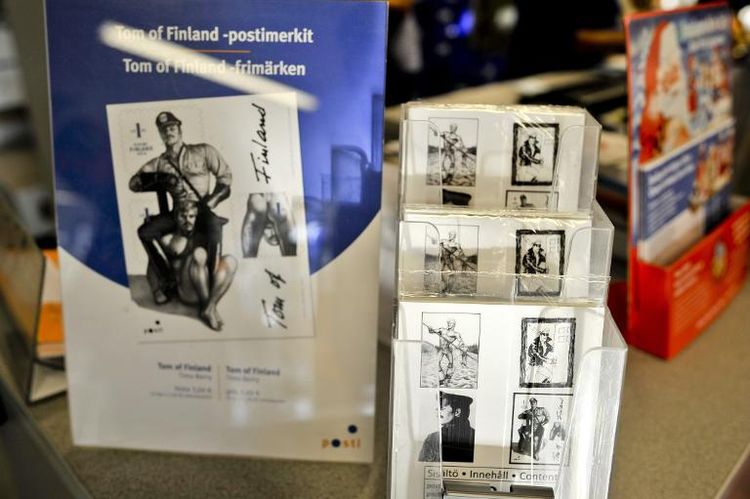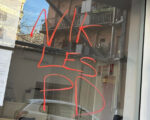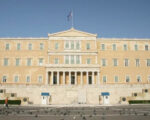>> Tom of Finland stamps on sale Monday; Finland’s biggest seller ever
[spacer]
Trois timbres rendant hommage à Tom of Finland, artiste majeur de l’homoérotisme au XXe siècle, ont été mis en circulation ce lundi, malgré une pétition de 4200 signatures. Les instigateurs y dénoncent la diffusion à l’étranger d’une imagerie ne faisant pas partie des « valeurs culturelles » de la société finlandaise.
De son vrai nom Touko Laaksonen (1920-1991), Tom of Finland a signé plus de 3500 dessins et peintures au cours de sa carrière, des dessins érotiques évocateurs à l’époque où l’homosexualité était encore un tabou, y compris dans les pays occidentaux. Bûcherons, motards ou cow-boys, toujours bien membrés… le choix de la poste s’est porté sur deux réalisations en noir et blanc de la fin des années 1970 dont trois timbres ont été tirés.
« C’est magnifique que les images, qui dans le passé avaient dû être vendues sous le manteau, puissent maintenant être ouvertement collées sur des enveloppes et des cartes postales », s’est réjoui dans un entretien à la télévision finlandaise YLE le graphiste Timo Berry, en charge de choisir les dessins et concevoir ces timbres.
La Poste finlandaise a estimé que cette série était la publication de timbres « la plus médiatisée mondialement » : « Pendant les six mois qui ont précédé la mise en circulation, des pré-commandes en ligne avaient été passées depuis 178 pays. Notre objectif est de continuer de publier des timbres qui correspondent à notre temps », a indiqué le porte-parole de la Poste, Markku Penttinen, cité dans le communiqué.
Après la Finlande, le plus grand nombre des commandes ont été passées depuis la Suède, l’Angleterre, Les États-Unis et… la France 🙂
En parallèle, une exposition au musée postal de la ville de Tampere revient sur les correspondances de l’artiste depuis le début des années 1940. Enrôlé dans l’armée quand la Seconde Guerre mondiale éclate, Touko Laaksonen prend son pseudonyme à la fin des années 1950, avec ses premières publications dans le magazine américain Physique Pictorial. Il devient « Tom of Finland ».
[spacer]
>> Stamps designed as a tribute to homoerotic artist and gay icon Touko Laaksonen — also known as Tom of Finland — went on sale Monday. According to the postal service company Posti, the risqué stamps are the country’s biggest seller ever, with pre-orders made in 178 different countries. The stamps, which hold pride of place in the newly-opened postal museum in Tampere, attracted a long queue of individuals eagerly anticipating the first day issues.
The homoerotic stamps officially went on sale Monday, but even before then they had been in stiff demand, with pre-orders booked in 178 different countries. Apart from Finland, the greatest interest came from Sweden, Britain, the United States and France.
Touko Laaksonen or Tom of Finland is one of Finland’s best known artists. Posti said that the stamps have received more international attention than any other Finnish post mark, having been featured in traditional and social media, and online publications.
Posti officials said the stamps’ popularity took even them by surprise.
“We haven’t seen this kind of interest before in Posti’s history and we probably won’t again soon,” said Posti development chief Markku Penttinen.
“Our starting point was to get Touko Laaksonen’s artwork in our stamps. We know that he was very well-known globally. Of course the subject matter is also topical and much discussed. This equation has worked better than we anticipated,” Penttinen speculated.
Finland a pioneer in bold postage stamps
Penttinen pointed out that the homoerotic nature of the Tom stamps would prove too much for many other countries to swallow.
“But it’s not for us Finns. We want to live in our times,” he added.
Nor are Laaksonen’s figures the first time nudity has been featured on a Finnish postmark. The bare flesh was in the Finnish public eye as early as the 1950s.
“Even at that time people asked how Finland could be bold enough to print stamps with naked women in the sauna,” Penttinen recalled.
However while the Tom of Finland stamps have been broadly welcomed in Finland, there has been opposition to the brazen representations in some quarters.
Long lines in Tampere for first day issues
A new postal museum in Vapriikki, Tampere struck gold by coordinating first-day issues of the Tom stamps to coincide with the opening of the cultural centre. Patrons would not only get to buy the much-anticipated stamp, they’d also get stamps with the designer’s signature.
The opportunity proved to be highly popular, with long queues forming outside the museum. One patron was Elina Juvani, who planned to send the stamp off to Germany and Ukraine.
“A first day is a first day. I wanted to send off mail since it was possible in Tampere. No one has really seen this kind of stamp anywhere,” Juvani remarked.
Stamp designer ecstatic
The Tom of Finland postage stamps are the work of designer Timo Berry and are based on drawings by Touko Laaksonen. Berry had a wide range of material to choose from, since Laaksonen was an especially prolific artist who turned out more than 3,500 sketches during his career.
Berry said that he was thrilled to have been given the assignment.
“I was really over the moon, I jumped around the office,” Berry said while dispensing autographs at the Postal Museum.
The designer said he’d received a great deal of feedback on the images and was regaled with many stories about the significance of Laaksonen’s art.
“Tom of Finland’s greatest significance is that these gay figures were given their masculinity. Previously they had been portrayed as “girlish”. It’s great that these sketches that had to be sold in secret can now be publicly viewed on envelopes and postcards,” Berry enthused.
Tampere’s new postal museum opened with an exhibition featuring letters by Tom of Finland, “Closed Secrets” and reveals the Touko Laaksonen behind the Tom name. The display features Laaksonen’s correspondence from the 1940s until his death in 1991.


















